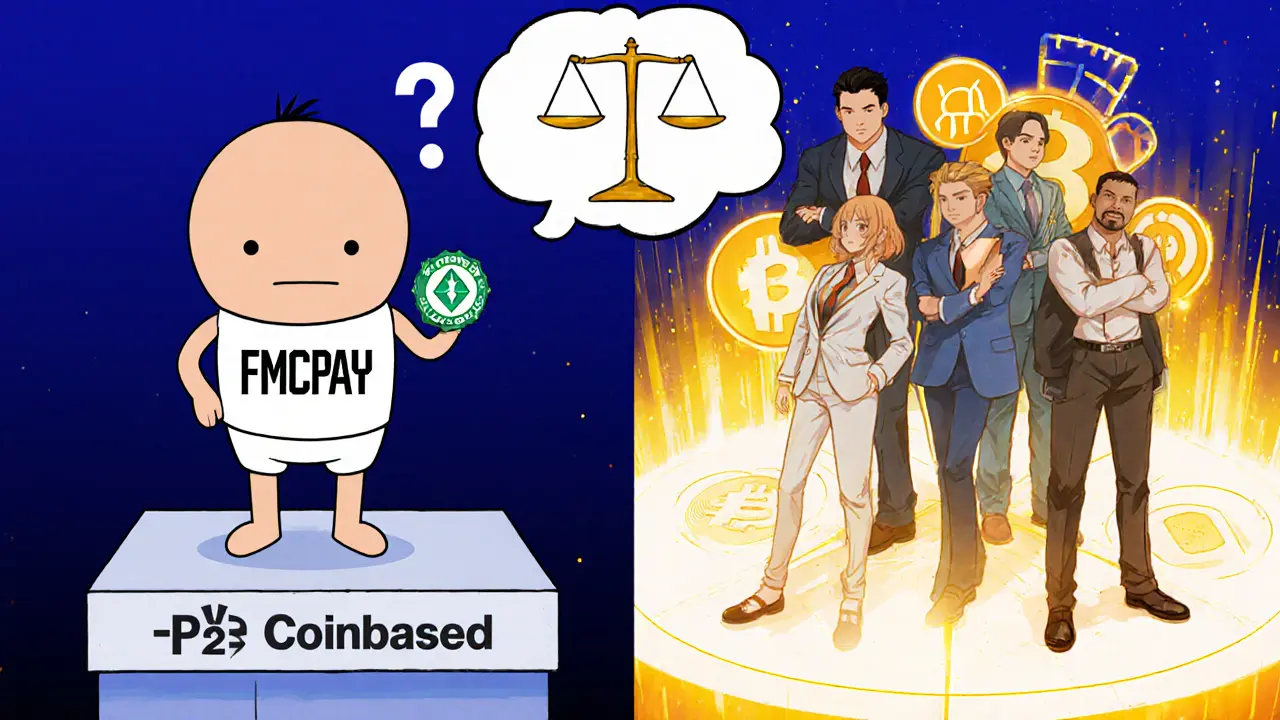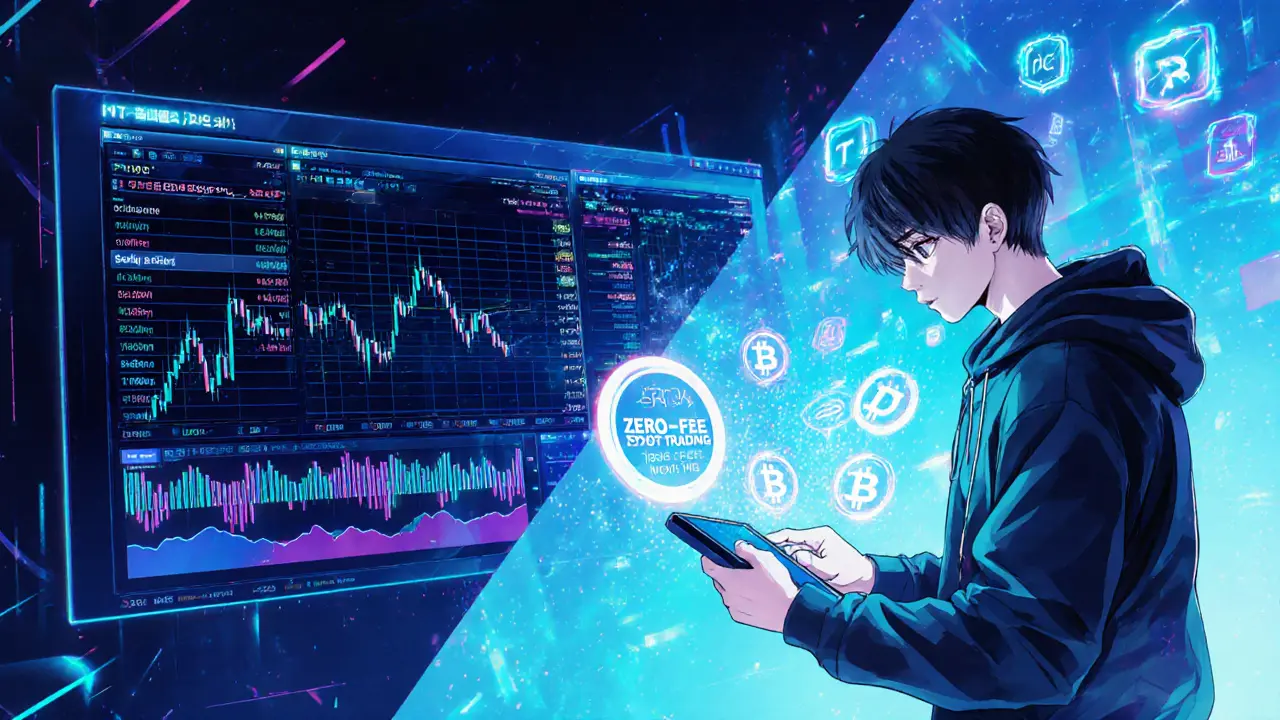FMCPAY Crypto Exchange Review 2025 - Security, Fees & Alternatives

FMCPAY Trading Fee Calculator
Calculate Your Trading Fee
FMCPAY charges a flat 0.2% fee for both maker and taker trades. Enter your trade amount to see exactly how much you'll pay.
Estimated fee: -
⚠️ Note: FMCPAY does not disclose exact trading volume data, so this is a simplified estimate based on their published 0.2% flat fee structure.
When you hear about a new crypto platform, the first question is always: is it safe enough to trust with my money? FMCPAY crypto exchange review cuts through the hype and gives you the hard facts - from how the platform works, to its security posture, fees, and how it stacks up against the big players.
Key Takeaways
- Founded in 2021, FMCPAY claims 2million users across 65countries, but its trading volume is untracked on major data sites.
- Security basics (encryption, MFA) are in place, yet technical details and audits are missing.
- No top‑tier regulatory licenses; users have limited recourse if something goes wrong.
- Offers P2P exchange and staking, but these features are also common on regulated exchanges.
- For risk‑averse traders, regulated platforms like Binance, Coinbase or Interactive Brokers are safer alternatives.
What Is FMCPAY?
FMCPAY is a cryptocurrency exchange launched in 2021 by U.S.-registered firm FUINRE Inc. The platform lets users trade over 30 digital assets, including Bitcoin (BTC), Ethereum (ETH) and Litecoin (LTC). FMCPAY also bundles staking services and a peer‑to‑peer (P2P) currency exchange, allowing users to swap fiat directly with each other.
How FMCPAY Positions Itself
The exchange markets itself as a one‑stop shop for basic crypto trading and staking, especially targeting regions where regulated exchanges face barriers. By November2024, FMCPAY reported serving 2million clients in 65countries, a growth claim echoed by Traders Union in its 2025 review.
Security Snapshot
Security is the first line of defense for any exchange. FMCPAY advertises:
- Standard encryption protocols (specific algorithms not disclosed).
- Multi‑factor authentication (MFA) - typically SMS or authenticator app.
- An internal client protection fund meant to cover user losses.
However, independent audits, cold‑storage ratios, and detailed technical specifications are absent. BrokerChooser flagged this lack of transparency as a major red flag, noting that without verifiable audits, users “have few options to get money back” if the platform is compromised.
Regulatory Landscape
Regulation is the biggest differentiator between FMCPAY and mainstream exchanges. FMCPAY does not hold licenses from tier‑one regulators such as the SEC (U.S.), FCA (U.K.), or ASIC (Australia). This places the exchange in the same risk bucket as many offshore platforms that operate without formal oversight.
In contrast, platforms like Coinbase and Binance maintain multiple regulatory approvals, offering users insurance funds and a clearer legal recourse.

Trading Fees & Costs
FMCPAY keeps its fee structure simple: a flat 0.2% maker/taker fee on spot trades. Staking rewards are advertised at market‑average rates, but the platform does not publish exact yield percentages for each asset.
Other exchanges often have tiered fee schedules that reward high‑volume traders. For example, Kraken offers fees ranging from 0% to 0.26% depending on 30‑day trading volume. Without a transparent volume metric-FMCPAY is listed as “untracked” on CoinMarketCap-it’s hard to verify how competitive FMCPAY’s flat fee truly is.
Liquidity & Trading Volume
Liquidity determines how quickly you can enter or exit positions without slippage. FMCPAY’s “untracked” status means that daily trading volume isn’t publicly available, making it difficult to gauge order‑book depth. By comparison, Binance processes billions of dollars in daily volume, ensuring tight spreads for most assets.
Pros and Cons Summary
| Aspect | Pros | Cons |
|---|---|---|
| Ease of Use | User‑friendly web UI, mobile app (implied) | Limited documentation on onboarding |
| Asset Variety | 30+ cryptocurrencies, staking options | No access to fiat‑on‑ramp beyond P2P |
| Security | Encryption, MFA, internal fund | Lack of third‑party audits, unclear cold storage |
| Regulation | None required for rapid market entry | No top‑tier licenses, higher legal risk |
| Fees | Flat 0.2% fee, simple structure | Potentially higher than volume‑based tiers |
| Liquidity | Appeals to niche regional markets | Untracked volume; unknown depth |
How It Compares to Major Exchanges
Below is a side‑by‑side look at FMCPAY versus three well‑known platforms. The comparison focuses on the attributes most relevant to everyday traders.
| Feature | FMCPAY | Binance | Coinbase | Kraken |
|---|---|---|---|---|
| Year Launched | 2021 | 2017 | 2012 | 2011 |
| Regulatory Licenses | None (top‑tier) | Multiple (EU, US, Asia) | US, UK, EU | US, EU |
| Supported Crypto | 30+ | 500+ | 200+ | 300+ |
| Staking | Yes (unspecified rates) | Yes (varies) | Yes (limited) | Yes (varies) |
| P2P Fiat | Yes | Yes | No | No |
| Typical Fee | 0.2% flat | 0.1%‑0.02% tiered | 0.5%‑0% tiered | 0%‑0.26% tiered |
| Liquidity (24h Volume) | Untracked | $70B+ | $5B+ | $2B+ |
| Security Audits | None disclosed | Regular third‑party audits | Annual SOC2, audits | Annual audits |

Who Might Still Choose FMCPAY?
If you live in a country where big exchanges are blocked or face heavy KYC requirements, FMCPAY’s P2P model could be appealing. Its simple fee schedule and lack of stringent verification mean you can start trading quickly. However, you should treat any funds on the platform as high‑risk capital - only invest what you can afford to lose.
Alternatives Worth Considering
Below are three regulated platforms that offer similar features with stronger safeguards:
- Binance - massive liquidity, robust security, and a wide range of staking products.
- Coinbase - user‑friendly, fully regulated in the U.S., insurance on custodial assets.
- Interactive Brokers - not a pure crypto exchange but provides crypto exposure under strict regulatory oversight, ideal for investors who need integrated portfolio management.
How to Get Started on FMCPAY (If You Decide to Try)
- Visit the official website and click “Sign Up”.
- Enter your email, set a strong password, and confirm via the verification link.
- Enable MFA in the security settings - preferably an authenticator app rather than SMS.
- Complete the optional KYC (basic ID upload) if you plan to use P2P fiat.
- Deposit crypto from an external wallet or use the P2P marketplace to acquire fiat‑linked crypto.
- Start trading - select a market pair, set limit or market order, and confirm.
Remember to withdraw any profits to a personal wallet you control, especially if you intend to hold long‑term.
Red Flags to Watch
- No public audit reports or third‑party security certificates.
- Untracked trading volume on major market data sites.
- Absence of top‑tier regulatory licenses.
- Customer support limited to a single email address without clear response times.
Frequently Asked Questions
Is FMCPAY a regulated exchange?
No. FMCPAY operates without top‑tier regulatory licenses such as those from the SEC, FCA, or ASIC. This means user funds are not covered by the same investor protection schemes that regulated platforms provide.
How secure is FMCPAY?
FMCPAY uses basic encryption and multi‑factor authentication, but it does not publish independent audit reports or details on cold‑storage practices. Security is therefore considered moderate at best.
What fees does FMCPAY charge?
A flat 0.2% maker/taker fee on spot trades. Staking rewards are offered at market‑average rates, but exact percentages are not disclosed.
Can I use FMCPAY for fiat withdrawals?
Yes, via its P2P marketplace, where users trade fiat directly with each other. Traditional bank withdrawals are not a core feature.
How does FMCPAY’s liquidity compare to Binance?
Liquidity on FMCPAY is unclear because the platform is listed as “untracked” on CoinMarketCap, meaning its 24‑hour volume isn’t publicly reported. Binance processes tens of billions of dollars daily, offering far tighter spreads.


Matthew Homewood
August 27, 2025 AT 17:56Reading through the FMCPAY review makes me reflect on the nature of trust in digital finance. While the platform advertises basic security measures, the absence of transparent audits feels like a philosophical void. Users are asked to believe in a black‑box without evidence, which challenges the principle of informed consent. In an ecosystem where we already grapple with volatility, adding opacity can erode the very foundation of rational decision‑making. So, think of FMCPAY as a mirror that reflects only what you want to see, not necessarily the full picture.
Jeff Moric
August 29, 2025 AT 00:29That's a great point about informed consent. For anyone considering FMCPAY, it's worth weighing the simplicity of their fee structure against the lack of regulatory oversight. If you live in a region where big exchanges are blocked, the P2P model can be a lifeline, but you should still treat the funds as high‑risk. Diversifying across a couple of platforms can mitigate potential losses while you test the waters.
Bruce Safford
August 30, 2025 AT 07:02Yo, you folks are missing the big picture. FMCPAY is just a front for the deep state to siphon crypto from unsuspecting users. They hide the real audit reports because the CIA is already inside their servers. If you think MFA is enough, think again – they've probably got backdoors you can't even imagine. The whole "no top‑tier licenses" thing is intentional, so they can operate in the shadows and avoid any accountability. Trust no one, especially not a site that claims "encryption" without naming the algorithms. It's all a massive scapegoat for the elite to control the market.
Jordan Collins
August 31, 2025 AT 13:36While it's easy to get swept up in alarmist claims, the reality is that most platforms, including FMCPAY, rely on standard industry practices. Without verifiable third‑party audits, it's a legitimate concern, but we should also consider that many boutique exchanges operate successfully with limited public documentation. For users focused on security, employing personal safeguards-like using hardware wallets and enabling authenticator apps-remains essential regardless of the exchange's internal measures.
Andrew Mc Adam
September 1, 2025 AT 20:09Alright, folks, let me break this down in the most dramatic fashion possible. FMCPAY swoops onto the crypto scene like a magician promising rabbits from an empty hat. First, they brag about a "flat 0.2% fee"-a sweet deal, you say? Yet they hide their trading volume like a secret treasure, leaving you guessing whether there's any liquidity at all. Imagine trying to sell Bitcoin and watching the price flutter like a leaf in a storm because the order book is nothing but a phantom.
They claim encryption and MFA, but without a third‑party audit, it’s like locking a door with a paperclip-technically closed, but anyone can pry it open. Their internal fund sounds comforting, but where’s the proof it’s backed by actual assets? It’s like a safety net made of sheer silk-appears strong until the weight comes crashing down.
Now, think about the regulatory vacuum. No licenses from the SEC, FCA, or ASIC means they dodge the safety nets that big players are forced to install. If the house burns down, you’re left on the streets with no insurance.
On the flip side, the P2P fiat platform could be a lifesaver for those stuck behind tight KYC walls. Still, you’re trading trust for convenience-like swapping a sturdy bridge for a flimsy rope over a canyon.
My final advice? Treat FMCPAY like an exotic spice-use it sparingly, taste it first, and never make it the main ingredient of your portfolio. Diversify, keep the majority of your assets on regulated, audited exchanges, and only risk what you’re prepared to lose. In the wild west of crypto, you either become a legend or a cautionary tale, and FMCPAY is leaning heavily toward the latter.
Ken Lumberg
September 3, 2025 AT 02:42Morally, supporting an unregulated platform is irresponsible.
Blue Delight Consultant
September 4, 2025 AT 09:16From a philosophical standpoint, the appeal of FMCPAY lies in its promise of accessibility, yet the ethical implications of operating without oversight cannot be ignored. While the platform may democratize entry into crypto markets for under‑served regions, it simultaneously relinquishes the safeguards that protect participants from systemic risk. In essence, the trade‑off between inclusivity and accountability becomes a central tension that users must navigate.
Wayne Sternberger
September 5, 2025 AT 15:49I appreciate the balanced view. If you do engage with FMCPAY, I recommend keeping only a minimal amount there and transferring any profits promptly to a hardware wallet you control. This mitigates exposure while still allowing you to test the platform's features.
Gautam Negi
September 6, 2025 AT 22:22Contrary to popular belief, the lack of regulation may actually be a strategic advantage for FMCPAY, allowing it to innovate faster than bureaucratic giants. While others cling to compliance, FMCPAY can adapt to niche markets and tailor its services without the drag of red tape. That agility, however, comes with hidden perils-namely the potential for opaque governance and unchecked risk.
Linda Campbell
September 8, 2025 AT 04:56As an American citizen, I find it disconcerting that we allow our compatriots to gamble with their assets on a platform that evades our nation's financial safeguards. It is a betrayal of the patriotic duty to protect one's wealth within the regulated framework established by our authorities.